"Emka" & "Deshka"
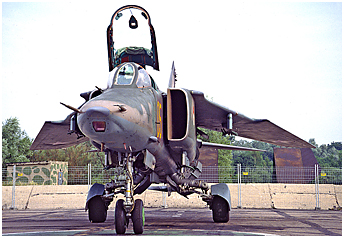
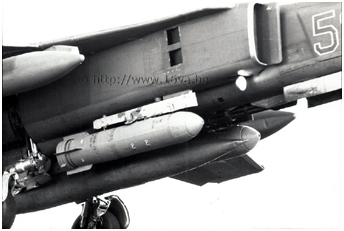 An insufficient number of MiG-27K were built because of its excessive production costs. Consequently, the development of an aircraft more capable than the MiG-27 "Flogger-D" but less expensive than a MiG-27K - even if
some of the latter's capabilities were sacrified - was launched very early.
From April 1976, a MiG-27 was modified to become the prototype of the MiG-27M (Product 32-29) of which 148 copies were built at the Plant n°99 in Ulan-Ude (Buryatia) between 1978 and 1984.
The new PrNK-23M weapon system installed in the MiG-27M did not have all the capabilities of the Kayra mounted in the MiG-27K.
The fuselage nose of the new "Flogger-J" regained an aspect close to that of the "Flogger-D". A Klen-PM (Maple) laser rangefinder and target designator was housed there, with the receiving antenna of the Product
141M (SPS-141M/142 ECM complex) mounted above it. The old S-17VG-1 HUD was retained, while the digital computer became the Orbita 10-15-23M model. The RSBN Korall-I and RSDN-10 Skip-2 navigation systems
of the MiG-27K were retained. The big difference with the MiG-27 and the MiG-27K therefore was the Klen-PM. The rangefinder function of the new laser developed by the Ural Optics and Mechanical Plant (UOMZ)
in Sverdlovsk was effective up to a distance of 10 km, while the target designation function had a range of 7 km . The optical head could swivel 12° in azimuth and +6°/-30° in elevation, i.e. a deflection less important
than that of the electro-optical bloc of the Kayra system. Thus, if the weapons range of the MiG-27M (1) was almost identical to that of the MiG-27K, the use of
KAB-500L laser-guided bombs was no longer possible (that of the laser-guided missiles remained).
An insufficient number of MiG-27K were built because of its excessive production costs. Consequently, the development of an aircraft more capable than the MiG-27 "Flogger-D" but less expensive than a MiG-27K - even if
some of the latter's capabilities were sacrified - was launched very early.
From April 1976, a MiG-27 was modified to become the prototype of the MiG-27M (Product 32-29) of which 148 copies were built at the Plant n°99 in Ulan-Ude (Buryatia) between 1978 and 1984.
The new PrNK-23M weapon system installed in the MiG-27M did not have all the capabilities of the Kayra mounted in the MiG-27K.
The fuselage nose of the new "Flogger-J" regained an aspect close to that of the "Flogger-D". A Klen-PM (Maple) laser rangefinder and target designator was housed there, with the receiving antenna of the Product
141M (SPS-141M/142 ECM complex) mounted above it. The old S-17VG-1 HUD was retained, while the digital computer became the Orbita 10-15-23M model. The RSBN Korall-I and RSDN-10 Skip-2 navigation systems
of the MiG-27K were retained. The big difference with the MiG-27 and the MiG-27K therefore was the Klen-PM. The rangefinder function of the new laser developed by the Ural Optics and Mechanical Plant (UOMZ)
in Sverdlovsk was effective up to a distance of 10 km, while the target designation function had a range of 7 km . The optical head could swivel 12° in azimuth and +6°/-30° in elevation, i.e. a deflection less important
than that of the electro-optical bloc of the Kayra system. Thus, if the weapons range of the MiG-27M (1) was almost identical to that of the MiG-27K, the use of
KAB-500L laser-guided bombs was no longer possible (that of the laser-guided missiles remained).
| ORBAT 1976 - 1994 |
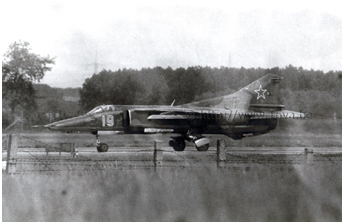
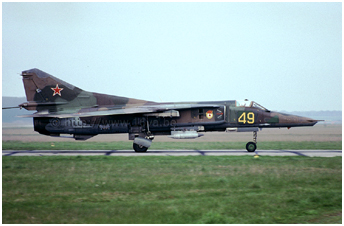 On the other hand, TV-guided weapons such as the KAB-500Kr bombs or the Kh-29T missiles remained current. The images captured by their sensors were transmitted directly to the IT-23M screen mounted on the right
side of the instrument panel as in the MiG-27K. Just like the K, the M model did not have a Del'ta radio guidance system or an S-13 camera. It also had LERXes with part of the antennas of the SPO-15L
radar warning receiver at their ends. Since the MiG-27M was lighter than the "Flogger-J2," the cockpit side armor plates were always mounted, like on the "Floggger-D." The MiG-27M production in a factory specialized
in the manufacture of the Mi-8 helicopters, did not go without quality problems, particularly in terms of parts interchangeability compared to the MiG-27D whose production started in 1983.
Since the MiG-27M had capabilities clearly superior to those of the MiG-27 and finally quite close to those of the MiG-27K, the decision was taken to modify the existing "Flogger-D" to bring them to standards identical
to those of the MiG-27M. The modified aircraft took the MiG-27D designation (Product 32-27), while the NATO designation "Flogger-J" was common to the MiG-27M and D. It was indeed impossible,
without knowing where to look, to distinguish externally the two versions. The first modified aircraft flew in 1982.
The modernization of each aircraft took an average of four to six months. To maintain combat readiness in each regiment, no more than four aircraft were sent to the factories at the same time.
Out of a total of 360 MiG-27 produced in Irkutsk, 304 copies were brought to MiG-27D standards between 1983 and 1989.
On the other hand, TV-guided weapons such as the KAB-500Kr bombs or the Kh-29T missiles remained current. The images captured by their sensors were transmitted directly to the IT-23M screen mounted on the right
side of the instrument panel as in the MiG-27K. Just like the K, the M model did not have a Del'ta radio guidance system or an S-13 camera. It also had LERXes with part of the antennas of the SPO-15L
radar warning receiver at their ends. Since the MiG-27M was lighter than the "Flogger-J2," the cockpit side armor plates were always mounted, like on the "Floggger-D." The MiG-27M production in a factory specialized
in the manufacture of the Mi-8 helicopters, did not go without quality problems, particularly in terms of parts interchangeability compared to the MiG-27D whose production started in 1983.
Since the MiG-27M had capabilities clearly superior to those of the MiG-27 and finally quite close to those of the MiG-27K, the decision was taken to modify the existing "Flogger-D" to bring them to standards identical
to those of the MiG-27M. The modified aircraft took the MiG-27D designation (Product 32-27), while the NATO designation "Flogger-J" was common to the MiG-27M and D. It was indeed impossible,
without knowing where to look, to distinguish externally the two versions. The first modified aircraft flew in 1982.
The modernization of each aircraft took an average of four to six months. To maintain combat readiness in each regiment, no more than four aircraft were sent to the factories at the same time.
Out of a total of 360 MiG-27 produced in Irkutsk, 304 copies were brought to MiG-27D standards between 1983 and 1989.
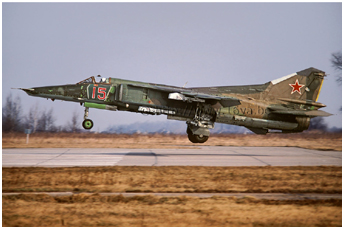
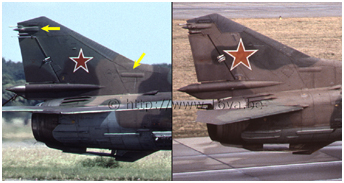 While some were modified by the ARZ 117 in Sknilov (Lvov) and the ARZ 322 in Vozdvizhenka, the main part, that is to say 242 airframes, were done in Irkutsk.
The latter were easily identified - at least as long as they had not been overhauled and repainted - to the false second cockpit painted behind the real one in order to pass them off as MiG-23UB two-seater aircraft
also manufactured on site. Without it, it was necessary to focus over the vertical fin to distinguish a D from an M model.
One of the transponder antennas was located at the top of the MiG-23's fin, its pointed, rounded dielectric panel protruding above the rudder.
It was extended by a fairing on the sides of the fin. The latter was unchanged on the MiG-27D, therefore identical to that of the MiG-27. On the other hand, that of the MiG-27M
had a slightly different shape. Another difference that could be seen on the fin was related to the R-864B HF radio, that was first installed in the MiG-27K. Its antenna was hidden behind the dielectric fairing of the
leading edge of the fin and an oblong fairing, not present on the MiG-27, was visible where the dorsal fin meet the vertical fin, on each side.
While some were modified by the ARZ 117 in Sknilov (Lvov) and the ARZ 322 in Vozdvizhenka, the main part, that is to say 242 airframes, were done in Irkutsk.
The latter were easily identified - at least as long as they had not been overhauled and repainted - to the false second cockpit painted behind the real one in order to pass them off as MiG-23UB two-seater aircraft
also manufactured on site. Without it, it was necessary to focus over the vertical fin to distinguish a D from an M model.
One of the transponder antennas was located at the top of the MiG-23's fin, its pointed, rounded dielectric panel protruding above the rudder.
It was extended by a fairing on the sides of the fin. The latter was unchanged on the MiG-27D, therefore identical to that of the MiG-27. On the other hand, that of the MiG-27M
had a slightly different shape. Another difference that could be seen on the fin was related to the R-864B HF radio, that was first installed in the MiG-27K. Its antenna was hidden behind the dielectric fairing of the
leading edge of the fin and an oblong fairing, not present on the MiG-27, was visible where the dorsal fin meet the vertical fin, on each side.
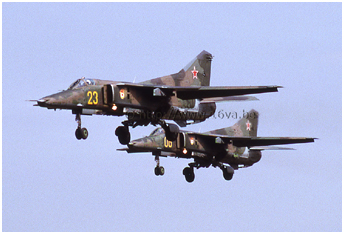
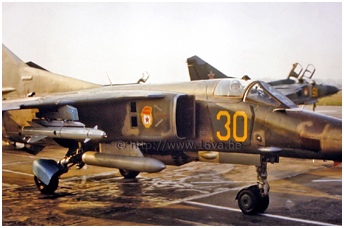 This fairing was existing for the same reasons on the MiG-27M and D. However,
on the MiG-27D directly derived from the MiG-27 (unlike the MiG-27K and M models built as such), it was necessary to add this fairing. This is how we can observe (especially on the right side) the outline of the added
metal sheet with the oblong stamping. However, the unsatisfactory R-864B radio was later removed from the MiG-27D.
The technical manual related to the radio-electronic equipment of Product 32-27 published in 1983 specified the operations to be carried out to remove the relevant equipment, including the "block B5B-JL"
(HF output stage > Link) located precisely at this location. A filling/drainage point for the water-alcohol mixture
intended to cool this block was located at the same level on the left side.
This fairing was existing for the same reasons on the MiG-27M and D. However,
on the MiG-27D directly derived from the MiG-27 (unlike the MiG-27K and M models built as such), it was necessary to add this fairing. This is how we can observe (especially on the right side) the outline of the added
metal sheet with the oblong stamping. However, the unsatisfactory R-864B radio was later removed from the MiG-27D.
The technical manual related to the radio-electronic equipment of Product 32-27 published in 1983 specified the operations to be carried out to remove the relevant equipment, including the "block B5B-JL"
(HF output stage > Link) located precisely at this location. A filling/drainage point for the water-alcohol mixture
intended to cool this block was located at the same level on the left side.
At the beginning of the nineties, before the withdrawal from Germany, the two regiments equipped with the MiG-27D and M had a rather homogeneous fleet of aircraft. The 19.GvAPIB only had MiG-27D in its inventory
and the 296.APIB 2/3 of MiG-27M and 1/3 of MiG-27D. As for the other two fighter-bomber "Flogger" units, the 559. and the 911.APIB, their fleet was solely composed of MiG-27K. However, many aircraft movements took place
within the units before getting there.
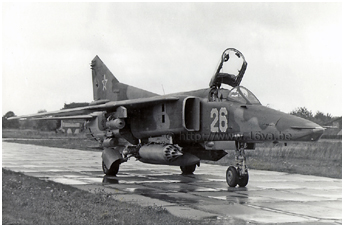
 While all the regiments were initially equipped with the "Flogger-D," MiG-27K also flew alongside them within the 19.Gv and the 559.APIB from 1979 for one and 1983 for the other.
The 296.APIB was an exception, because when it got its first MiG-27 "Flogger-D" only in 1983, it also immediately received some "Flogger-J" (probably M, and later also D). Around 1985/86, this unit was finally equipped
only with MiG-27D and M. The 19.Gv.APIB could have received some MiG-27M in 1984. Pilots of the regiment have indeed conveyed planes of this type from Ulan-Ude in April. However, a testimony states that only the 296.APIB
flew on MiG-27M and it is quite possible that the delivery of April 1984 had Altenburg for final destination. Around 1987/88, the MiG-27K were withdrawn from the 19.GvAPIB, some joining the 559.APIB (as well as aircraft
from the 88.APIB). Thus, Lärz was left with only MiG-27D models. In July/August 1989, when the size of the VVS regiments was downsized from 45 to 32 aircraft, a dozen MiG-27D from the 19.GvAPIB joined the ranks of the 1.GvAPIB
of Kunmadaras in Hungary, which was replacing its Su-17M2. The 559.APIB meanwhile took delivery of MiG-27D in the mid-eighties replacing of its "Flogger-D." These "Flogger-J" would have been former "Flogger-D" of the regiment.
The unit was finally entirely equipped with MiG-27K from 1988/89. The 911.APIB that arrived in the GDR only in 1989 had a full complement of MiG-27K since 1986. However, it went to Brand airfield with only the strength of a
single squadron (although the regimental personnel was almost complete), the missing planes being made available by the other units of the 16.VA.
While all the regiments were initially equipped with the "Flogger-D," MiG-27K also flew alongside them within the 19.Gv and the 559.APIB from 1979 for one and 1983 for the other.
The 296.APIB was an exception, because when it got its first MiG-27 "Flogger-D" only in 1983, it also immediately received some "Flogger-J" (probably M, and later also D). Around 1985/86, this unit was finally equipped
only with MiG-27D and M. The 19.Gv.APIB could have received some MiG-27M in 1984. Pilots of the regiment have indeed conveyed planes of this type from Ulan-Ude in April. However, a testimony states that only the 296.APIB
flew on MiG-27M and it is quite possible that the delivery of April 1984 had Altenburg for final destination. Around 1987/88, the MiG-27K were withdrawn from the 19.GvAPIB, some joining the 559.APIB (as well as aircraft
from the 88.APIB). Thus, Lärz was left with only MiG-27D models. In July/August 1989, when the size of the VVS regiments was downsized from 45 to 32 aircraft, a dozen MiG-27D from the 19.GvAPIB joined the ranks of the 1.GvAPIB
of Kunmadaras in Hungary, which was replacing its Su-17M2. The 559.APIB meanwhile took delivery of MiG-27D in the mid-eighties replacing of its "Flogger-D." These "Flogger-J" would have been former "Flogger-D" of the regiment.
The unit was finally entirely equipped with MiG-27K from 1988/89. The 911.APIB that arrived in the GDR only in 1989 had a full complement of MiG-27K since 1986. However, it went to Brand airfield with only the strength of a
single squadron (although the regimental personnel was almost complete), the missing planes being made available by the other units of the 16.VA.
| "Flogger" versions evolution at unit level | ||
|---|---|---|
| Units | Type & date | Units composition |
| 559.APIB (Su-7BM) | MiG-27 - 1975 MiG-27K - 1983 MiG-27D - 1984 |
MiG-27 & MiG-27K - 1983 MiG-27K (1.AE) & MiG-27D (2./3.AE) - 1983/84 > 1988 MiG-27K (1./2./3.AE) - 1988 |
| 19.GvAPIB (Su-7BM) | MiG-27 - 1976 MiG-27K - 1979 MiG-27D - 1983/84 |
MiG-27 & MiG-27K - 1979 MiG-27K & MiG-27D - 1984 > 1988 MiG-27D (1./2./3.AE) - 1988 |
| 296.APIB (MiG-21SMT) | MiG-27 - 1983 MiG-27M - 1984 MiG-27D - 1985? |
MiG-27 & MiG-27M - 1984 MiG-27M & MiG-27D (1./2./3.AE) - 1985 |
| 911.APIB (MiG-21S) | MiG-27 - 1981 MiG-27K - 1982 MiG-27D |
MiG-27K (1./2./3.AE) - 1986 |
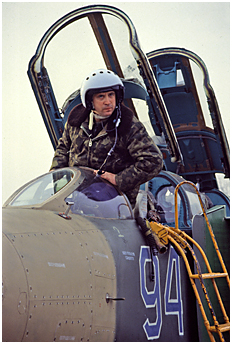 Le colonel Sergeï Borisyouk, dernier commandant du 559.APIB monte à bord d'un MiG-23UB le
22 mars 1993. Son esprit est ailleurs... © H.Mambour.
Le colonel Sergeï Borisyouk, dernier commandant du 559.APIB monte à bord d'un MiG-23UB le
22 mars 1993. Son esprit est ailleurs... © H.Mambour.
The last 559.APIB commander, colonel Sergey Borisyuk climbs aboard a MiG-23UB on March 22, 1993. His mind is elsewhere... © H.Mambour.
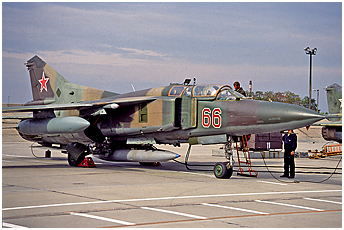 The MiG-23UB "Flogger-C" already briefly studied in the third part of this chapter ensured the training and meteorological flights within the units equipped with the different versions of the MiG-27.
One can also wonder about the exact role of the MiG-23UB n°61 (s/n 39040074 built in 1983) of the 296.APIB from Grossenhain. This aircraft was indeed a one of a kind, probably locally modified.
It had indeed two additional antennas, one mounted on the top of the fuselage offset to the right and the other one mounted under the aircraft, offset to the left in front of the main landing gear housing.
The MiG-23UB "Flogger-C" already briefly studied in the third part of this chapter ensured the training and meteorological flights within the units equipped with the different versions of the MiG-27.
One can also wonder about the exact role of the MiG-23UB n°61 (s/n 39040074 built in 1983) of the 296.APIB from Grossenhain. This aircraft was indeed a one of a kind, probably locally modified.
It had indeed two additional antennas, one mounted on the top of the fuselage offset to the right and the other one mounted under the aircraft, offset to the left in front of the main landing gear housing.
Brand's 911.APIB was the first "Flogger" unit to leave the skies of Germany. On June 22 and July 1, 1992, its MiG-27K and MiG-23UB took off for a very short stage flight to Finsterwalde before finally taking off on
July 6 for Lida in Belarus, the very place where the regiment came from three years earlier. The unit was disbanded a year later and its aircraft transferred to Baranovichi, still in Belarus, where a
"base for the disposal of aeronautical equipment" (BLAT) was located, wher they were destroyed.
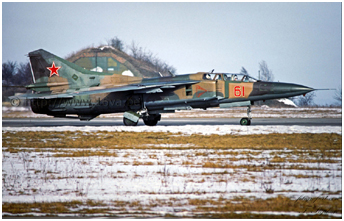
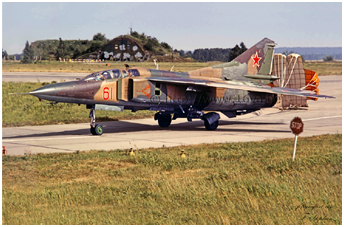 The final evacuation of the other MiG-27 finally took place on March 22 and 23, 1993 in a kind of final apotheosis. In two days, about one hundred of these planes departed the last three bases that they still occupied.
On March 22 in the morning, at 8 a.m. local time, the thirty-six remaining aircraft of the 559.APIB under the orders of Colonel Sergey Borisyouk, flew away in pairs, from five to five minutes,
of Finsterwalde. They were followed from 11 a.m. by their colleagues of the 296.APIB from the neighboring airbase of Grossenhain with the MiG-23UB n°61 opening the ball. The next day, on March 23,
the thirty MiG-27D and eight MiG-23UB of the 19.GvAPIB under the command of Colonel Marat Kutuyev, left Lärz in turn for the CIS via Polish airspace. For this great eastward migration from Germany
of the Russian MiG-27 regiments, the Poles had opened an air corridor from Frankfurt-on-Oder (Germany) to Brest-Litovsk (Belarus) and authorized the use of the Polish airbase in Inowroclaw as an emergency diversion platform.
The Antonov An-26RTR n°06 had obviously been mobilized for the occasion in order to serve as a radio relay, or even as a flying command post. It was indeed redeployed to Finsterwalde the day before or very early in the morning,
taking off ahead of the first MiG-27 wave.
The final evacuation of the other MiG-27 finally took place on March 22 and 23, 1993 in a kind of final apotheosis. In two days, about one hundred of these planes departed the last three bases that they still occupied.
On March 22 in the morning, at 8 a.m. local time, the thirty-six remaining aircraft of the 559.APIB under the orders of Colonel Sergey Borisyouk, flew away in pairs, from five to five minutes,
of Finsterwalde. They were followed from 11 a.m. by their colleagues of the 296.APIB from the neighboring airbase of Grossenhain with the MiG-23UB n°61 opening the ball. The next day, on March 23,
the thirty MiG-27D and eight MiG-23UB of the 19.GvAPIB under the command of Colonel Marat Kutuyev, left Lärz in turn for the CIS via Polish airspace. For this great eastward migration from Germany
of the Russian MiG-27 regiments, the Poles had opened an air corridor from Frankfurt-on-Oder (Germany) to Brest-Litovsk (Belarus) and authorized the use of the Polish airbase in Inowroclaw as an emergency diversion platform.
The Antonov An-26RTR n°06 had obviously been mobilized for the occasion in order to serve as a radio relay, or even as a flying command post. It was indeed redeployed to Finsterwalde the day before or very early in the morning,
taking off ahead of the first MiG-27 wave.
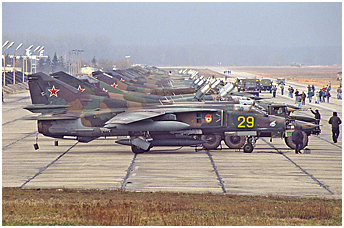
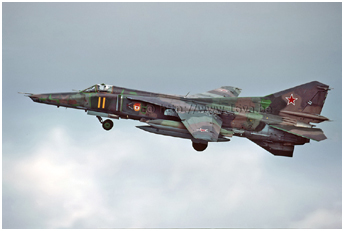 The final destination of the aircraft of the regiments from Finsterwalde, Grossenhain and Lärz is known.
It was the 4215.BRS (Baza Rezerva Samoletov - Reserve Base for Aircraft) located in Chebenki (Dmitriyevka) near Orenburg in the Urals where, after a journey in three stages with stopovers in Bobruisk (Belarus)
and Lipetsk (CIS), these aircraft were put in storage (> Photos).
Unlike many other units that were disbanded when their aircraft were retired, three of the four MiG-27 regiments of the 16.VA remained in the order of battle of the Russian Federation.
Thus the regiments from Grossenhain and Finsterwalde were both assigned to the Russian military district of the North Caucasus where, equipped with Su-24M "Fencer-D" bombers, they formed (with the 959.BAP of Yeisk)
the spearhead of the 10.BAD of the new 4.VA of Rostov-on-Don. The 296.APIB became the 296.BAP after mastering the "Fencer" at Morozovsk and then moved to Marinovka, west of Volgograd, while the 559.BAP,
remained on this southern Russian base. The 296.BAP was finally disbanded in 1998, while the 559.BAP is now assigned to the 4th Army of the VVS and PVO and flies on Su-34 "Fullback."
The 19.GvAPIB from Lärz, became the 19.GvIAP and joined Millerovo airbase until its disappearance in 2009.
The conversion of the 19.GvAPIB into a fighter unit equipped with MiG-29 had already begun in 1993 in Germany when some pilots went to Wittstock and Damgarten to familiarize themselves with their future aircraft on a flight
simulator.
The final destination of the aircraft of the regiments from Finsterwalde, Grossenhain and Lärz is known.
It was the 4215.BRS (Baza Rezerva Samoletov - Reserve Base for Aircraft) located in Chebenki (Dmitriyevka) near Orenburg in the Urals where, after a journey in three stages with stopovers in Bobruisk (Belarus)
and Lipetsk (CIS), these aircraft were put in storage (> Photos).
Unlike many other units that were disbanded when their aircraft were retired, three of the four MiG-27 regiments of the 16.VA remained in the order of battle of the Russian Federation.
Thus the regiments from Grossenhain and Finsterwalde were both assigned to the Russian military district of the North Caucasus where, equipped with Su-24M "Fencer-D" bombers, they formed (with the 959.BAP of Yeisk)
the spearhead of the 10.BAD of the new 4.VA of Rostov-on-Don. The 296.APIB became the 296.BAP after mastering the "Fencer" at Morozovsk and then moved to Marinovka, west of Volgograd, while the 559.BAP,
remained on this southern Russian base. The 296.BAP was finally disbanded in 1998, while the 559.BAP is now assigned to the 4th Army of the VVS and PVO and flies on Su-34 "Fullback."
The 19.GvAPIB from Lärz, became the 19.GvIAP and joined Millerovo airbase until its disappearance in 2009.
The conversion of the 19.GvAPIB into a fighter unit equipped with MiG-29 had already begun in 1993 in Germany when some pilots went to Wittstock and Damgarten to familiarize themselves with their future aircraft on a flight
simulator.
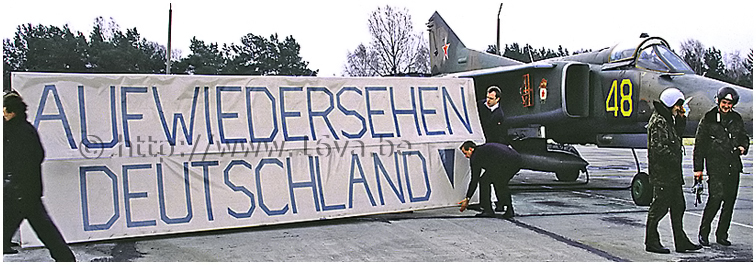 Lärz, March 23, 1993. © H.Mambour.
Lärz, March 23, 1993. © H.Mambour.
 |
MiG-27 PHOTO PAGE |  |
notes
(1)
In addition to conventional bombs and unguided rockets up to 240mm, the MiG-27D and M could carry:
- Kh-25L and ML (AS-10 "Karen") and Kh-29L (AS-14 "Kedge") laser-guided missiles.
- KAB-500Kr TV-guided bombs.
- Kh-29T (AS-14 "Kedge") TV-guided missiles.
- A Del'ta-NG2 pod was attached under the right air intake to control Kh-23/M (AS-7 "Kerry") and Kh-25MR (AS-10 "Karen") radio-guided
missiles.
- A BA-58 V'youga (Blizzard) pod was attached under the right air intake to detect and identify the enemy radar emissions and relay the
information to Kh-25MP (AS-12 "Kegler") and Kh-27PS (AS-12 "Kegler") anti-radar missiles. It had to be configured before the flight.
- The Kh-31P (AS-17 "Krypton") ARM was tested from the mid-1980s. It was used in conjunction with a Progress designation pod.
However, the demise of the USSR did not permit its development for the MiG-27.
- A PA-10 reconnaissance container was likely to be carried under the right air intake.
~~~~~~~~~~~~~~~~~~~~~~~~~
 |
 |
An adaptation of this article has been published in the issues n°489 and 490 (December-January and February-March 2023-24) of the French aviation magazine Air Fan.
 |
Plan du site - Sitemap |  |
